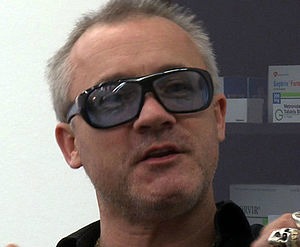
TALK about time-expired: Damien Hirst’s work, now showing in a major retrospective at Tate Modern, has had its day in more ways than one. Not only are the pickled sharks, sheep and fish showing signs of decay but sales of his work have plummeted.
Channel 4’s Four Rooms, a little-known TV series, exposed the Hirst’s collapse the week the show opened. In the series, owners of artworks bargain with four buyers, each of whom sits in a separate room. Offers must be accepted on the spot: there’s no going back. If the offer in the first room happens to be the highest, and you refuse, bad luck.
This was the predicament of the two oddballs who owned a fish and chip shop in Leeds to which Hirst once gifted one of his pickled herrings. As soon as the Brit Art bad boy won the Turner Prize, the chippies consigned the piece to Bonhams with a reserve of £100,000, which it failed to reach. Withdrawn at £80,000, the forthcoming Tate show gave the guys a second chance to cash in on the Hirst name.
The first dealer offered them a staggering £40,000. She was flatly turned down. It went from bad to worse until the boys reached the last room where a pomandered antique dealer was forced to cough up £20,000 after losing a wager. He immediately proclaimed the fish to be worth £60,000.
Why am I telling you all this? Not to show the ugly cupidity of art dealers or because I am addicted to daytime-like TV but because the episode defines what Hirst’s work represents. Hirst is a manufacturer of luxury goods, his art is a commodity, nothing more. But the bubble has burst. Little birds in the art market are tweeting that Hirst’s day is done. “It’s impossible to unload dot paintings,” says one market expert, who added that Jay Joplin, Hirst’s dealer, was trying to stop the rot by buying in anything that appeared on the market. Last year, the highest price for a Hirst was down to $1.7m, compared to $19m in 2007.
At 46, Hirst is certainly wealthy. His diamond-studded skull For the Love of God (which he called a critique of capitalism) is the most popular exhibit at the Tate Modern show. He claimed it was sold for £50 million to an anonymous cartel then admitted that he was one of the new ‘owners’ when the Art Newspaper outed the truth. But in terms of art sales, Hirst is now way behind Gerhard Richter, whose work earned almost $200m in auction sales, while the Chinese painter Zeng Fanzhi now lays claim to being the richest artist in the world.
Visitors to Tate Modern queuing up for an hour to spend £15 to gain entry to the Hirst show will mostly be unaware of all this back-stabbing. It is after all one of the world’s great galleries, a wonderful exhibition space created originally by Gilbert Scott as a power station but now a major attraction in itself. That Hirst got here in itself is a stamp of approval and collectors are hopeful the retrospective will halt the market slide.
I declined the small hagiography offered at the door because I did not want to throw up over the sort of drivel which Hirst is famous, like: “You get cab drivers and stuff who come up to me and they go (sic) “What you do is not art, mate. I’m sure there were people around when they were doing it in the caves, going ‘I like your cave, but I hate that crap you’ve got on the walls.’”
But in the event I nearly threw up in the second room where A Thousand Years — a rotting cow’s head in a pool of blood being devoured by maggots –is showing. Not because of the exhibit itself but because of the odure. Despite a well-made display case, there is a distinct escape of smell.
Unfortunately the queue for the living butterfly exhibit In and Out of Love started here so there was no avoiding it. I’d come for the butterflies, which I had not seen but had heard much about. Art critic Brian Sewell is particularly savage on the subject: “all who care for living things should boycott this exhibition”. But the room with its canvases smeared with the excrement of the hatched pupae and potted plants from Homebase or B&Q was a dismal let down – conceited, poorly staged, inconsequential, a minor extension of the dreary theme of the transience of life. And there were no display cases.
The display cases are good, the real stars of the show, but Hirst did not make them. He does not make anything. His big idea of displaying his work as specimens does make good use of the Tate Modern’s soaring exhibition rooms, however. The show is an exhibition of stunning costly display cases. You could put anything in those cases and it would look interesting – or dull – depending on whether you liked being dragged around the Natural History Museum as a 6 year old or not.
The show was meant to have travelled on to the Museum of Contemporary Art (MOCA) in Los Angeles. But allegedly, the museum has had to put the idea on hold because hosting the show would exceed its entire annual budget, so at least America will be spared this (literally) rotten exhibition.

